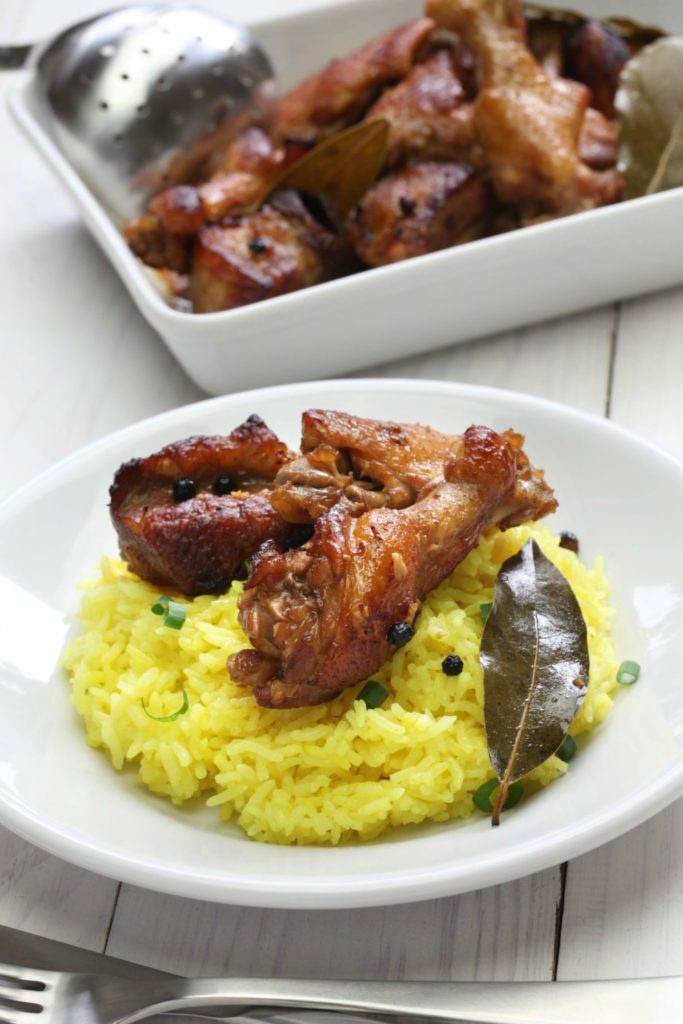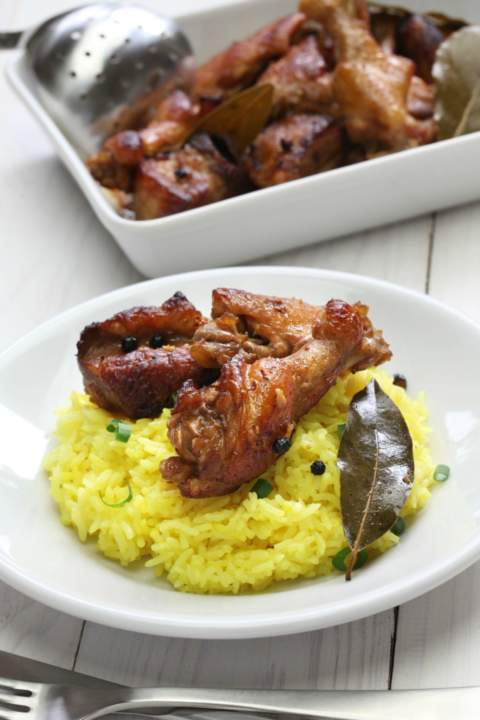Hello! At Relax Lang Mom, a Filipino mom food blog, I share recipes that connect everyday life to the kitchen.
Adobo is at the center of every Filipino table, just vinegar, soy sauce, garlic, and patience. This is my classic chicken and pork adobo recipe, the one I cook for my family and the one I recommend if you’re learning adobo for the first time.
I realize I have been remiss in posting this classic Chicken and Pork Adobo recipe in my blog. The Filipino adobo is such throw together and simmer affair that I always forget that maybe some people would require a recipe guide. Adobo is one of those Pinoy recipes that you can just open your fridge and raid the pantry and put everything together thing.
A Bit of Filipino Food History
Food historian Doreen Fernandez often reminded us that “to eat Filipino food is to taste history.” The history of Filipino adobo is older than its name. Long before the Spanish gave it the label adobar (to marinate), early Filipinos were already cooking meat in vinegar and salt to preserve food in the tropical climate. When Chinese traders brought soy sauce and Spaniards introduced garlic, the dish evolved into the version most Filipinos know today. What we think of as “classic” adobo is really a palimpsest of influences coming from indigenous preservation, Chinese condiments, and Spanish naming conventions.
As you might know, there are as many kinds and versions of the Pinoy adobo as there are days in the year. Some like their Adobo sweet, some add tomatoes, some use coconut milk or gata. Some are pure chicken or pure pork. (Or fish, for that matter).
Regional Adobo Recipes
Also, across the country, you’ll find adobo with regional flair. In Batangas, for example, there’s Adobo sa Pula, colored by achuete seeds that give the dish a reddish tint. In the north, Ilocanos make Adobo sa Asin, stripped of soy sauce altogether and seasoned simply with salt, garlic, and vinegar. Bicolanos lean into their love of gata with Adobo sa Gata, creamy, spicy, and fragrant with chilies. In our island in Marinduque we have the special Dinilawan or Adobo sa Dilaw. Each region holds on to the same roots of preservation but bends the dish to its own environment, palate, and produce.
A Dish That Adapts
Every household makes it differently, which is why Fernandez once called adobo the “national dish without a decree.” It travels well, keeps for days, and tastes even better the longer it sits. Its a perfect companion for workers in the fields, students in boarding houses, or families stretching their meals through the week. The adaptability of adobo mirrors Filipino resilience, the ability to make do with what is on hand and still turn it into something memorable.
Some like their Adobo sweet, some has tomatoes, some have coconut milk or gata. Some are pure chicken or pure pork. (Or fish for that matter).
But you can also have a combination like this recipe of Chicken and Pork Adobo. My kind of Chicken and Pork Adobo is tostado. I usually let it boil till there’s no more liquid left and the leftover oil is used to fry the meat. This leaves a tasty almost fried adobo goodness. This is my second adobo this week and I hope you enjoy it!
But you can also have a combination like this recipe of Chicken and Pork Adobo. My kind of Chicken and Pork Adobo is tostado. I usually let it boil till there’s no more liquid left and the leftover oil is used to fry the meat. This would leave a tasty almost fried adobo goodness. This is my second adobo this week and I hope you enjoy it!
My Tostadong Chicken and Pork Adobo Recipe
Classic Filipino Chicken and Pork Adobo
Ingredients
- 1/2 kilo Pork Adobo Cut
- 1/2 kilo Chicken Adobo Cut
- 1 head garlic, peeled and minced
- 1 tbsp patis (fish sauce)
- ½ teaspoon pepper corns
- 2 bay leaves
- 1 cup water
- ½ cup vinegar
- ¼ cup vinegar (1)
- ¼ cup soy sauce
- 1 tablespoon oil
- 3 to 4 Thai chili peppers, stemmed and chopped
- salt to taste
Instructions
- In a pot, add pork, chicken, patis and vinegar (1) and bring to a boil till liquid is evaporated and meat is almost golden.
- Add garlic, peppercorns, bay leaves, water, vinegar and soy sauce.
- Over medium heat, bring to a boil for about 10 minutes and let liquid evaporate. Lower heat, let meat be fried in the rendered oil for about 10 - 15 minutes or until meat is golden brown.
- Season with salt to taste. Serve hot.

Pin this image to your Pinterest!
Adobo comes in all sorts of flavors and styles too! I’ve shared several versions you might enjoy. If you like a little heat, try my Saucy & Spicy Pork Adobo Ribs. For mornings, there’s Crispy Adobo Silog Fried Rice. Looking for something different? I’ve made Bottled Adobo Pate, Ginataang Adobo sa Dilaw with coconut milk and turmeric, and seafood favorites like Adobong Pusit and Adobong Bangus Sardines. You can even go lighter with Adobong Kangkong. Each one carries the same Filipino mom cooking spirit, with a flavor of its own.
Why Adobo Endures
Adobo keeps because it’s about preservation and memory. The sourness of vinegar and the salt of soy sauce bring us back to kitchens where parents or lolas stirred a simmering pot, teaching without words. The same dish can be breakfast, lunch, dinner, and tomorrow’s baon. It changes form but never loses its essence. Maybe that’s why it has lasted through centuries. Because it speaks both of survival and of comfort.


